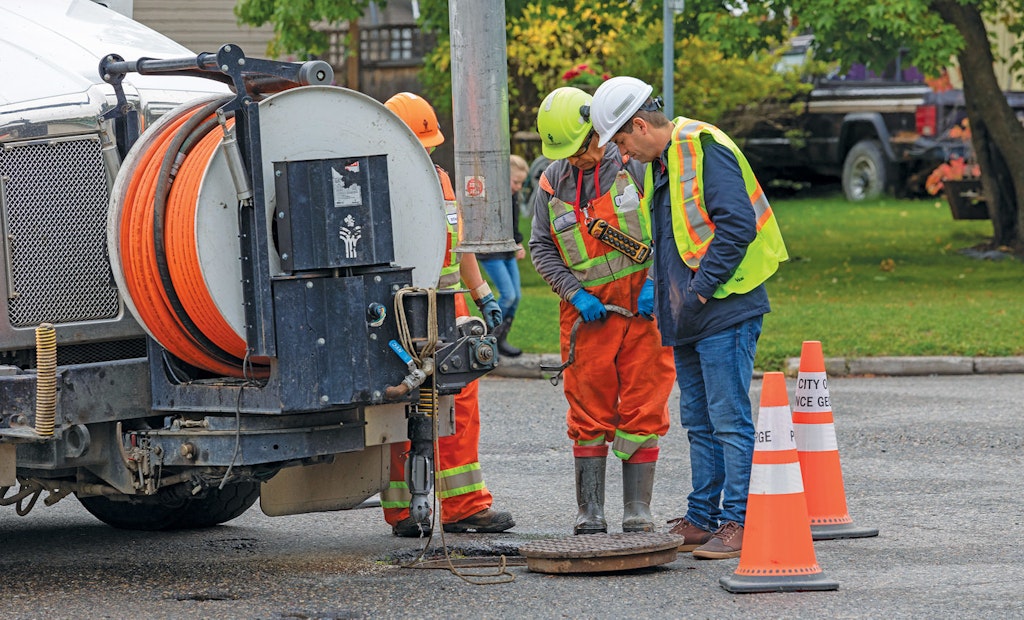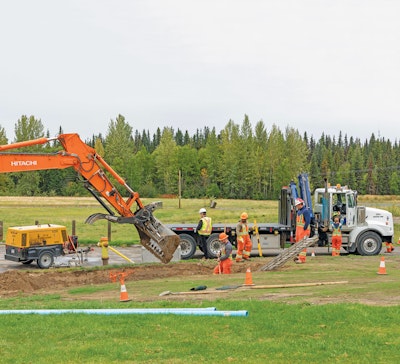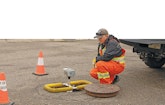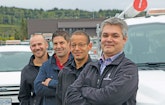
Equipment operator Loyd Marchand and supervisor Jon LaFontaine use a Vacall combo unit to flush oil and grease from a sanitary sewer line.
Interested in Infrastructure?
Get Infrastructure articles, news and videos right in your inbox! Sign up now.
Infrastructure + Get AlertsFrom energy to drinking water, sanitary sewers to stormwater management, the city of Prince George (British Columbia) Utilities Division does it all — in a sustainable way that limits the environmental impact all around the system.
Headed by Wil Wedel, utilities manager, the Prince George team is responsible for a unique caisson-lateral system that delivers the city’s drinking water cost-effectively, a sewer program that focuses on source control, stormwater management to reduce pollution of nearby rivers, and the operation of an energy recovery loop that heats downtown buildings.
It’s all part of an integrated community sustainability plan designed to be a model of sustainable cities across Canada and centered on the concept that a healthy environment supports a robust and stable economy.
Drinking water
The “Northern Capital” of British Columbia, Prince George is the largest city in the northern part of the province, situated at the confluence of the Fraser and Nechako rivers.
To serve the population of 78,000, about 10.3 million gallons of drinking water are produced each day, stored in 14 reservoirs and distributed to 22,000 homes and businesses through approximately 350 miles of pipes and 10 pumping stations. Most of the water is drawn from three interconnected wellheads consisting of a large underground concrete caisson and several lateral pipes that collect groundwater that seeps from the aquifer near the Nechako River.
Each caisson is over 98 feet deep, with a network of laterals extending in each direction. The wells each have a capacity to draw about 423 gallons from the aquifer per second. Electric pumps then move the water to the surface where it is disinfected through the use of sodium hypochlorite, generated on site.
“The use of the laterals greatly enlarges the aquifer field each well can draw from,” Wedel says.
Instead of drawing water from a single point, this system can draw from 160 feet in each direction from the caisson.
Wedel says each caisson can house up to 11 laterals per level, with some caissons having two levels. The second level is available for future demands.
Other benefits of the caisson system include system redundancy, the ability to supply the entire city from one location, and low operating costs — basically limited to loading bags of salt for the on-site hypo system.
While the installation can be costly, Wedel says, the day-to-day operation is minimal. “We get high volume at low cost,” he says.
Prince George also withdraws water from four other smaller sites, which serve a separate water system, and can provide supplementary water and serve as a backup.
The Prince George system is monitored and tested regularly, with 90 samples taken every month and sent to the British Columbia Centre for Disease Control. The natural filtering of the groundwater prevents the presence of Cryptosporidium or Giardia, and buffered chemistry of the city’s water limits the leaching of heavy metals. For example, Prince George scored one of the lowest concentrations of lead in the province.
Leaks are detected by inspecting and repairing waterlines as streets are repaved.
Wastewater treatment
Wastewater is collected and directed to the treatment plant through 292 miles of gravity and force mains and another 139 miles of sewer laterals.
The utility repairs and replaces broken sewers or sewer connections using both open-trench excavation and pipe lining with cured-in-place pipe and cast-in-place plastic liner.
At the plant, screens remove plastics, rags and grit ahead of primary clarifiers. Biological treatment is provided by trickling filters followed by a mixing tank and final clarification. Treated, disinfected effluent is discharged to the Fraser River. The plant is designed for a population of 115,000 with design peak flow of approximately 30 mgd. Actual average daily flow is between 6 and 7 mgd.
Solids are digested, dried and spread on area farm fields and forestlands in accordance with the province’s Organic Matter Recycling Regulation. Microturbines use the biogas produced in the digester to create both energy and heat and also create a considerable reduction in energy costs when in operation.
The Prince George sewer system averages about 500 calls a year for vacuuming and flushing using the city’s three Vacall combo units.
These calls result primarily from roots growing into the lines and by improper disposal of grease, wipes, diapers, lint and other items flushed down the toilet.
For that reason, and to protect the Fraser River, the city pays close attention to source control, conducting a Sewer Smart public education program and recently adopting a new sanitary sewer bylaw affecting what customers can discharge to the system.
Sewer Smart
Begun in 2015, the source control team advises customers about Sewer Smart practices to use at home and at work. “Many household items like wipes, paper towels, diapers and hygiene products can cause buildup and blockages in pipes and pumps. Even items promoted as ‘flushable’ do not always break down in the sanitary sewer system. Blockages damage pipes and treatment systems and cause sewage backups,” advises the utility’s website. The advice is followed by a list of items that should not be disposed of down the sewer.
Wedel says that in addition to the website information, users are advised through a local newsletter and media outlets.
The website also links to the Water Environment Federation’s Will It Flush? program.
While the Sewer Smart program has reduced unwanted materials in sewers, Wedel is even more hopeful about the new sanitary sewer bylaw going before the City Council in the fall of 2019 and expected to take effect in 2020.
Developed by city staff in consultation with stakeholders — and in particular industrial and commercial users — the new bylaw is meant to create a more comprehensive and fair approach to wastewater treatment costs while encouraging treatment of harmful substances at their source.
Wedel says the source control team has worked closely with food industries, auto repair shops, car washes and other entities to identify harmful substances in their waste stream and develop ways to remove them at the source.
“We’ve had meetings with businesses and area residents to discuss the bylaw. In many cases, these users did not understand the potential impact of what they were doing.”
Many users simply needed to implement solutions already in place with their existing plumbing. In other cases, modifications or changes to production processes were called for. “In the case of car washes, the issues are the volume of water as well as sediment and debris. The problem can be solved simply by proper maintenance of existing debris traps,” he says.
“The goal is to create a level playing field with all of us on the same page.”
Stormwater management
Both the sanitary sewer and storm sewer programs are designed to prevent contamination of the Fraser River, one of western Canada’s major rivers and a valuable habitat for fish, including all species of Pacific salmon.
The Utilities Division maintains an elaborate system designed to prevent sediment, road salt, sand and other debris from reaching the river. It includes over 800 culverts, 4,000 manholes, 5,500 catch basins, 426 miles of open ditch and drainage channels and 194 inlet structures.
Storm flow, most serious during the spring snowmelt, is conveyed through 224 miles of underground pipe. Some of it is stored in stormwater storage basins where sediment settles. The system includes 318 discharge points.
Wedel says the major maintenance tasks revolve around cleaning the basins. “It’s a pretty intensive effort,” he says. The Prince George maintenance crews use Vacall hydroexcavators to remove the material, much of which is salt and sand used to keep area roads open during the winter.
Renewable energy
Not all water utilities are responsible for energy. But in Prince George, the Utilities Division operates and maintains a renewable energy system that heats a cluster of buildings in the downtown area and cuts energy costs and greenhouse gas emissions at the same time.
The system takes advantage of the close proximity of Lakeland Mills, a producer of high-end stud lumber, located at the edge of the central city. The mill provides waste heat from its drying process and wood-waste burners to a system of belowground pipes throughout the central city. The pipes are made of thin-walled steel, jacketed with insulation.
The heat is exchanged against water to produce hydronic heat in the library, City Hall, Royal Canadian Mounted Police building, the convention center, an art gallery, the Wood Innovation and Design Centre, a swimming pool and provincial courthouse.
Wedel explains that heat exchangers are located at each building on the system and that the utility maintains a peaking energy center, fired by natural gas, as a backup to the heating system. “The renewable energy system operates about 90% to 95% of the time with heat from the mill,” he says.
More buildings could be added to the system in the future, as long as they are along the piping network.
European model
The concept for the renewable energy system is based on similar systems in Europe and was the result of a 2010 contract agreement between the utility and mill.
Both economic and environmental benefits are being realized. Buildings on the system have seen energy cost reductions as much as 30%, as well as carbon credits, Wedel says, mainly because they don’t have to maintain their own boiler systems. The concept is also attractive to new businesses considering moving to the area, and it strengthens the relationship between the city and local businesses.
On the environmental side, the energy system has reduced total particulate matter (from the mill, as well as buildings on the system) and has cut greenhouse gas emissions by 1,984 tons per year. The program also supports the local forest products industry and has proven to be more cost-effective to implement than other potential renewable energy sources.
The overarching Prince George sustainability plan, developed through broad cross-cultural and community involvement, includes such strategies as strengthening downtown and neighborhood centers, protecting valuable open space, supporting green infrastructure and buildings, reconnecting with nature and the local culture, building on assets and encouraging growth that is beneficial to both the community and environment.
The city’s renewable energy program and water management plans are a perfect fit.
Voluntary metering
While all new residential construction and commercial and industrial customers must install water meters, Prince George, British Columbia, maintains a voluntary metering system for its existing water customers. Up until 2015, residential customers were charged a flat rate of $41.61 per month, irrespective of the amount of water they actually used.
“Residents in the city currently use more water than the provincial and the national average,” explains Wil Wedel, utilities manager. “There is clearly a need to move toward more conservative water use. The rationale behind the metering program is education; residents will be able to more accurately track their water use and conserve more as a result.
“If customers use less water than the average user, they will pay less. Plus, customers will be able to immediately detect leaks in their water system and be able to better monitor water conservation habits.”
The city began providing free voluntary water meters in 2016, installing 100 units for volunteers who sign a contract. Wedel says the meters are installed inside the home due to the cold winter temperatures. The voluntary program is going well, and the city has no plans to require mandatory metering in the near future.









